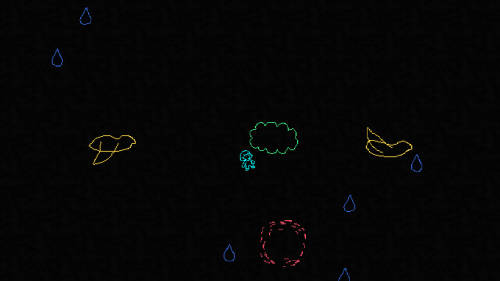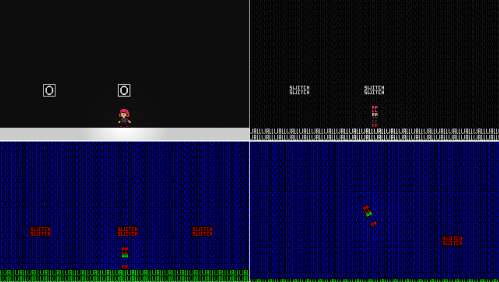PLAY THE GAME HERE:
https://friendlycosmonaut.itch.io/cpsarchiveobject
NOTE: it takes some time to load for the first time (textures may appear black). Please wait for it to load!
I chose to create a small game for my archival object. The majority of the Objects I created throughout the coursework were virtual interactive works, so a game which combined their interactivity and mechanics seemed natural. This is no surprise, as I am a game developer and most of my creative work to date has involved programming.
However, interactivity was not the only theme that linked my projects together. At the heart of most of my works, including my non-virtual and non-interactive works, was surprise, contrast, and playfulness. These themes were evident even in week 1: Observation, when I created a video that matched me playing piano where I swapped out the sounds of piano keys for sound effects I had recorded around RMIT (students talking, construction noise, keyboard clacks, etc). If I was going to represent the object, I wanted to make it surprising in some way, and what better way to do that then subvert the expectation of the viewer? Like the punch line of a joke, a surprise is often delightful and playful. Therefore, I wanted to emulate this surprise and contrast between the piano object and the “RMIT piano” object, by allowing the player to toggle what sounds would play from the virtual piano. Thus I developed the mechanic of using switches to toggle object states during the archive, which I would continue to use as an interaction point for the player for other weekly Objects.
Furthermore, by using a pixel art version of myself as the character, and a binary “on” or “off” switch for interactivity, I could inject some of my own character as a programmer into the work. Just as code is built from fundamental on or off building blocks, a core part of this game’s interactivity would be derived from flipping switches.
The second week where we explored Tinkering and I made a Particle Creator system was one where I felt most at home. Programming itself is a process of iteration and tinkering, the results of which can be beautiful. I recreated the particles and allowed them to be altered through six switches which toggled functionality on and off. Surprise and playfulness were incredibly important for this week’s project as well. During the creation of the original project, I had been extremely surprised and delighted when I combined functionality to discover emergent shapes and movement, and that when I showed others, they created different particles than I thought was possible. I wanted the player to feel similarly delighted by flicking and combining each switch to discover different combinations.
Next was the Found Objects week. This was the week I struggled the most to come up with a concept, and found myself feeling even more restricted in terms of scope than I would during the Forces week. My object was a drumstick, but I did not want to use it in any sort of conventional way: not as a source of sound or for keeping rhythm. Again, I found myself wanting to create some sort of surprise, and even though I did not create a virtual game, the work I produced was still interactive in a way: a collection of photos where the viewer could play “where’s Wally”, but with a drumstick. However, I did not want to strictly recreate this in a digital way, as I wanted to incorporate the use of switches. Therefore, I took one of my photos as inspiration: where the drumstick had been hiding among the sticks of a tree. Similarly, when the player would flick the switch during the archival game, all of the trees would turn into drumsticks. This allowed me to hit on some of the more surreal and ridiculous aspects of the week’s work, while maintaining the themes of the archive.
The next week’s piece was Place, where I had created a train that could stretch between two states: the first (red) a close and stifled state where the commuters have no room, and the second (blue) where every person has room to breathe. Although this work is interacted with through a sliding scale (in the original project, the mouse’s position, and in the archive, the player’s position), it still represented a contrast between to states. Instead of having the player interact with this Object through the switches, the switch simply acts as an entry point into this piece.
Next was Objects are Not Exhausted, where I had created an interactive experience where the player plays as a powerless particle that can only move very slowly, or grab onto other objects. By contrasting this section with previous sections where the player can move around and interact with objects easily, the sudden powerlessness of becoming a “particle” version of the character was more surprising. Furthermore, I wanted the player to engage with the more existential nature of the piece: the nature of identity and the hypothetical consciousness (or lack thereof) of a particle. I tried to highlight this by having the entry point for the object be a teleportation device, which in a lot of science-fiction stories and narratives involves breaking up an individual’s particles, sending them to a different location, and rebuilding the object. Thus the player’s experience during this time is one of being one such particle (and eventually, they are pulled in to the destination teleporter).
Next was Character, where I had developed a simulation for evolving Character through clothing preferences and weather. The work itself during this week was perhaps least consistent with my other themes, but I could still capitalise on creating a surprise for the player through unveiling the characters through interaction with the switch. Staging the characters in lines created a surreal and almost experimental environment, where the characters appeared like test subjects in a simulation. Like the train, I made the player’s position in the room the determining factor for interacting with the project: the player’s movement created iterations in the “simulation” and slowly showed the character’s eroding characters.
Next was the week on Time. The project I had created involved creating two distinct time environments, and using moving shapes to visualise the effects of the time, as their speeds and directions would be altered. Again, the switch was used as an entry point for this Object, and would toggle activation or deactivation of the “time warping” objects. This allowed me to include the aesthetic of the shapes as well as the idea of “time environments” that the player could move through and interact with. Just like the switches which continually ask the player “what will happen when you press me now?”, each shape is a surprising and playful question for the player to solve. To capitalise on the surprise and “warping” nature of these environments, I also made them alter the player sprite’s scale.
Finally was the week on Forces. During this week, I created a small space shooting game where the player’s goal is to shoot all the cannons in a world containing only text, red blue and green colours, and no gravity. To capitalise on the surprising element of each of these limitations, I allowed the player to turn them on one by one during the archive: first, turning everything into text (even the dust particles are changed to a single “A” letter), then to only red blue and green colours, and finally, for the climactic end of the game, switching off gravity. This final change also switches off all control the player has over the main character.
In conclusion, I have created a surreal adventure game to serve as an archive for the objects I have created during this course – a reflection of my own experience throughout the semester, which has been an equally bizarre and enjoyable journey.
About This Work
By Natasha Vranic-Peters
Email Natasha Vranic-Peters
Published On: 25/10/2019







